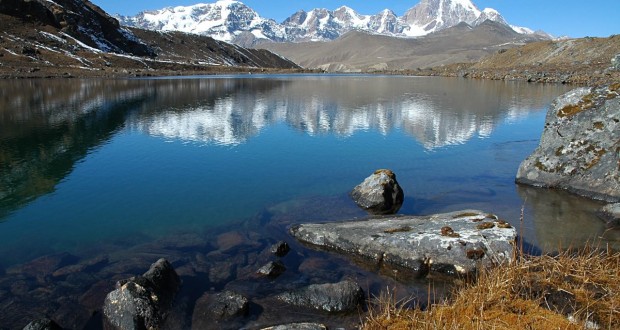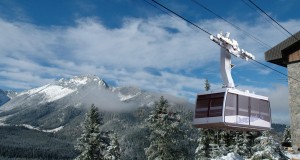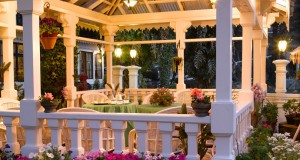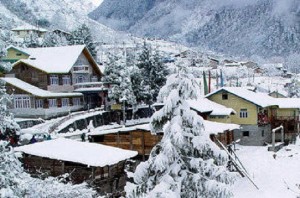 well as excursions to all nearby places of interest.City Sights Round-up (on foot, 4/5 hours) Royal Palace–Deer Park–Research Institute of Tibetology–Orchid Sanctuary- Do-Drul Chorten–Orchidarium Most of the town can be seen on foot, in a morning. Start at Tsuklakhang, the royal gompa (chapel) of the Chogyals (ex-rulers of Sikkim) in the grounds of the Royal Palace. This was once the most important gompa in Sikkim, site of the coronation ceremonies of the kings of Sikkim, of royal marriages and of celebrations to mark national and religious festivals. Appropriately, Tsuklakhang is a very elegant structure in typical Sikkimese style with carved and painted woodwork, murals, wall hangings and priceless Buddhist treasures. Among the important festivals still celebrated at Tsuklakhang are Pang Lhabsol held in mid-September in honour of Kanchenjunga the guardian deity of Sikkim; Kagyat in early December, which features a dance-drama enacted by Buddhist monks; Loosong, the Sikkimese New Year, also around this time; and Losar in February, to celebrate the Tibetan New Year.The Secretariat building, hub of the state administration, is to the south of the Royal Palace. This is a recent structure but built in traditional style, blending very well with the surrounding areas. The Deer Park is spread out in the valley below the secretariat and has a gilded statue of Buddha in a teaching pose, a replica of the statue at Sarnath.Established by the last Chogyal in 1958, the Research Institute of Tibetology
well as excursions to all nearby places of interest.City Sights Round-up (on foot, 4/5 hours) Royal Palace–Deer Park–Research Institute of Tibetology–Orchid Sanctuary- Do-Drul Chorten–Orchidarium Most of the town can be seen on foot, in a morning. Start at Tsuklakhang, the royal gompa (chapel) of the Chogyals (ex-rulers of Sikkim) in the grounds of the Royal Palace. This was once the most important gompa in Sikkim, site of the coronation ceremonies of the kings of Sikkim, of royal marriages and of celebrations to mark national and religious festivals. Appropriately, Tsuklakhang is a very elegant structure in typical Sikkimese style with carved and painted woodwork, murals, wall hangings and priceless Buddhist treasures. Among the important festivals still celebrated at Tsuklakhang are Pang Lhabsol held in mid-September in honour of Kanchenjunga the guardian deity of Sikkim; Kagyat in early December, which features a dance-drama enacted by Buddhist monks; Loosong, the Sikkimese New Year, also around this time; and Losar in February, to celebrate the Tibetan New Year.The Secretariat building, hub of the state administration, is to the south of the Royal Palace. This is a recent structure but built in traditional style, blending very well with the surrounding areas. The Deer Park is spread out in the valley below the secretariat and has a gilded statue of Buddha in a teaching pose, a replica of the statue at Sarnath.Established by the last Chogyal in 1958, the Research Institute of Tibetology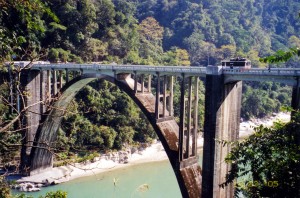 is the only institute of its kind in India and contains several rare Lepcha, Tibetan and Sanskrit manuscripts, statues and thangkas, as well as other priceless objects. Located on a hill-top south of the palace and open 10 am-4 pm Monday to Saturday, except the second Saturday of the month. Next to the Institute is an Orchid Sanctuary containing over 200 varieties of orchids found in the Himalayan region. The Do-Drul Chorten, close by, was built in 1945 by the venerable Trulsi Riponche, head of the Nyingma order of Tibetan Buddhism. Around the large gold-topped chorten are 108 Prayer Wheels which are turned by devout Buddhists; some pilgrims may complete several circuits of the chorten, spinning each wheel as they pass. Flanking Do-Drul are Chorten Lhakhang and Guru Lhakhang, containing two huge statues of Mahaguru Padmasambhava, who took Buddhism to Tibet.
is the only institute of its kind in India and contains several rare Lepcha, Tibetan and Sanskrit manuscripts, statues and thangkas, as well as other priceless objects. Located on a hill-top south of the palace and open 10 am-4 pm Monday to Saturday, except the second Saturday of the month. Next to the Institute is an Orchid Sanctuary containing over 200 varieties of orchids found in the Himalayan region. The Do-Drul Chorten, close by, was built in 1945 by the venerable Trulsi Riponche, head of the Nyingma order of Tibetan Buddhism. Around the large gold-topped chorten are 108 Prayer Wheels which are turned by devout Buddhists; some pilgrims may complete several circuits of the chorten, spinning each wheel as they pass. Flanking Do-Drul are Chorten Lhakhang and Guru Lhakhang, containing two huge statues of Mahaguru Padmasambhava, who took Buddhism to Tibet.
Peripheral Attractions (by bus/jeep-taxi, 3/4 hours)
In the afternoon take a bus or jeep-taxi 14 km (9 miles) south to the Orchidarium containing over 500 varieties of orchids found in the Himalayan region. Sikkim itself has over 600 species of orchid within its borders. At any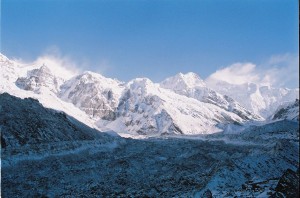 one time almost half those in the sanctuary may be in bloom although the best time is April and May. Back towards the town, near Siniolchu Lodge, about 3 km (1 2/3 miles) south-east of the main bazaar is the 200-year-old Enchey Monastery. The monastery is an important centre of the Nyingmapa order of Buddhism, built on the site blessed by Lama Druptob Karpo who is believed to have been given the ability to fly by the tantric powers at his command. In January (coinciding with the twelfth month of the Tibetan calendar) every year, the masked dance (chaani) is performed in this monastery with a great fanfare.Tashi View Point on the North Sikkim Highway about 8 km (5 miles) from Gangtok offers a spectacular view of the various monasteries on the surrounding hills, and the famous Siniolchu mountain peak. Take a jeep-taxi here to witness the sunrise or sunset.
one time almost half those in the sanctuary may be in bloom although the best time is April and May. Back towards the town, near Siniolchu Lodge, about 3 km (1 2/3 miles) south-east of the main bazaar is the 200-year-old Enchey Monastery. The monastery is an important centre of the Nyingmapa order of Buddhism, built on the site blessed by Lama Druptob Karpo who is believed to have been given the ability to fly by the tantric powers at his command. In January (coinciding with the twelfth month of the Tibetan calendar) every year, the masked dance (chaani) is performed in this monastery with a great fanfare.Tashi View Point on the North Sikkim Highway about 8 km (5 miles) from Gangtok offers a spectacular view of the various monasteries on the surrounding hills, and the famous Siniolchu mountain peak. Take a jeep-taxi here to witness the sunrise or sunset.
Organised Tours and Excursions
The Tourist Information Centre on M.G. Road (tel 2064) runs 3 tours. One is a morning tour covering much of what is outlined above. The second, an afternoon tour, includes the Orchidarium and Rumtek Monastery. A third tour takes in Phodang.
The Rumtek Monastery is the largest of its kind outside Tibet and is the seat of the ‘Kagyu’ order 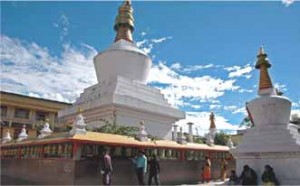 of Buddhism. Situated 24 km (15 miles) south-west of Gangtok in a lower valley, it is an almost exact replica of the original Kagyu headquarters in Tibet. The Rumtek Dharma Chakra Centre, as the monastery is properly known, houses several unique religious art objects. If you wish to visit independently, a local bus leaves Gangtok each afternoon for Rumtek and returns early the following morning. Accommodation is available at the monastery and the bus timings are such that if you are going to enjoy the area two nights must be spent there—not a bad thing as the monastery life is fascinating, and the lamas welcoming.
of Buddhism. Situated 24 km (15 miles) south-west of Gangtok in a lower valley, it is an almost exact replica of the original Kagyu headquarters in Tibet. The Rumtek Dharma Chakra Centre, as the monastery is properly known, houses several unique religious art objects. If you wish to visit independently, a local bus leaves Gangtok each afternoon for Rumtek and returns early the following morning. Accommodation is available at the monastery and the bus timings are such that if you are going to enjoy the area two nights must be spent there—not a bad thing as the monastery life is fascinating, and the lamas welcoming.
Forty kilometres (25 miles) north of Gangtok is Phodang Monastery. Of Sikkim’s 70 minor and major monasteries, Phodang is one of the 6 major monasteries. Though rebuilt in recent years, the Labrang Gompa retains the original structure and the old mural paintings and frescoes are fascinating.
TREKKING
For adventurous visitors, Sikkim is a delight as it offers several treks over a variety of terrain. Several package tours are organised by Sikkim Tourism and local trekking agencies.Yuksam, a 2-hour drive from Gangtok, is 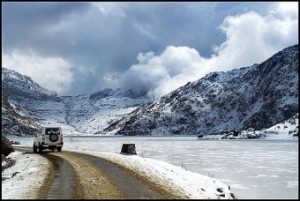 the base for many treks to the western mountain areas of the state, where the Himalayan Mountaineering Institute has a centre for its mountain climbing courses. This is also the place where the first ruling monarch of Sikkim was crowned by three lamas.
the base for many treks to the western mountain areas of the state, where the Himalayan Mountaineering Institute has a centre for its mountain climbing courses. This is also the place where the first ruling monarch of Sikkim was crowned by three lamas.
There are treks, from Yuksam to Bakhim (2740 m) and on to Dzongri (4030 m). Yuksam is also a day’s trek away from Pemayangtse which is the premier monastery of Sikkim with over 100 lamas drawn from many of Sikkim’s leading families. (Pemayangtse can also be reached by a full day’s car journey from Gangtok.) Built in 1705, the monastery has a fine collection of sculpture and thangkas. The holiest shrine of all Sikkim is Tashiding Monastery, a further day’s trek away from Pemayangtse. The mere sight of the monastery is supposed to absolve all sins, and each Spring pilgrims come to celebrate the festival of Bumchu. Trekking equipment—haversacks, sleeping bags, tents, etc. are available for hire from Sikkim Tourism and leading travel agents.

